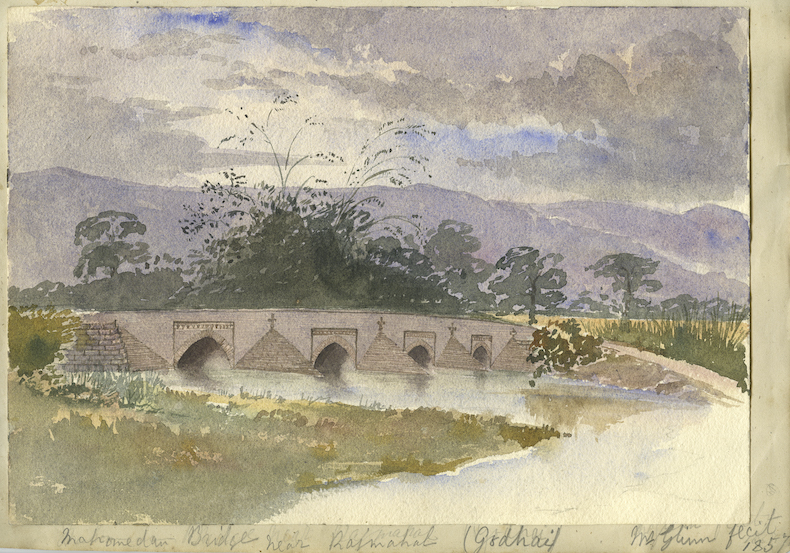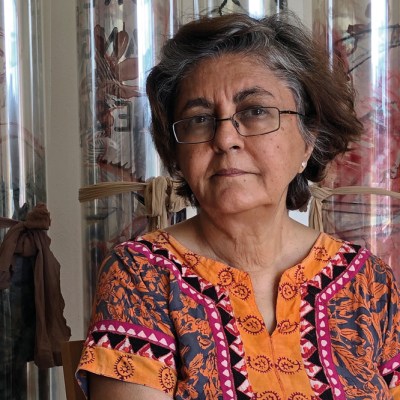Who counted in the British Empire, and what are the consequences of such hierarchies today? ‘Paper Cuts’ at the Peltz Gallery at Birkbeck, University of London, asks these questions by contrasting a colonial visual archive with contemporary artistic interventions. Subtitled ‘Art, Bureaucracy, and Silenced Histories in Colonial India’, the exhibition, curated by Surya Bowyer, displays drawings and watercolours collected by the Scottish engineer George Turnbull, who, from 1851 onwards, was the man responsible for building India’s first long-distance railway, from Calcutta to Benares.
‘Paper Cuts’ contrasts the by-products of a quintessential colonial project with works by the artists Divya Sharma and Ravista Mehra. Through its drawings and watercolours, the Turnbull collection shows how colonial engineers and officials anonymised and obscured the Indians who worked with and for them. Sharma and Mehra’s works highlight how new stories told through audio and visual material challenge that dehumanising act, highlighting Indian narratives in the face of their historical erasure.
Turnbull’s collection, formed of works created by his colleagues in India (and displayed as reproductions here to protect the original material), illustrates the mechanics of building a railway and the mechanics of maintaining an imperial life. To anyone familiar with this material – or with Orientalist representations more generally – the images are not so unusual: there are many portraits of unnamed Indians and drawings of Mughal buildings here. What is really striking about these images, however, is what they hide in plain sight; that Imperial know-how depended on other forms of expertise.
Mughal bridge near Rajmahal (1857), George James Hervey Glinn. Photo: National Railway Museum/Science & Society Picture Library

We view, for instance, a watercolour of a ‘Mughal bridge near Rajmahal’ painted in 1857 by George James Hervey Glinn. Yet as well as depicting the bridge’s architectural stylings, the image is also a piece of engineering evidence: sitting in swamplands that made railway construction difficult, the existing Mughal bridge showed one possible route across this troublesome terrain. Elsewhere, Turnbull filled his own notebooks with bridge designs that helped him to work out ways of traversing the nearby Sone River with rails, ultimately helping him to build what was then the longest river bridge in India.
The same is true of a watercolour from 1852 by G.W. Archer, which depicts Indian workers sitting waiting for the clay bricks they have just shaped to dry in the sun. As the accompanying caption states, the image focuses on ‘the bricks arranged in perfect lines’, not ‘the Indian workers, integral though they are to the brickmaking process’. Their skill and the visualisation of that skill is buried by the racial hierarchy. A pastel from 1852 by the railway engineer J. Slater of ‘George Turnbull’s bearer’ neither names the bearer nor defines him by anything other than his position of servitude (the bearer helped to carry a palki, a carriage supported by poles).
Bengali brickmaking (1852), G. W. Archer. Photo: National Railway Museum/Science & Society Picture Library

The contemporary artworks displayed throughout ‘Paper Cuts’ are visually arresting and an effective commentary on what Turnbull’s collection leaves out. Sharma’s blue-and gold patterned tapestry The Shape of Identity (2022) is a focal point for the exhibition, not just because of its appearance, but because of the history of the materials of which it is made. Sharma wove the piece on a base fabric of hemp, which has long been an important crop in India and which the British, in 1798, saw fit to start taxing. As the artist comments on the accompanying label, however, ‘nowadays, Western societies are increasingly turning to hemp as a fabric, medicine, and food source.’
(Mis)infographics (2021), Ravista Mehra. Photo: courtesy and @ the artist

Elsewhere, Mehra confronts viewers with the jarring differences in historical accounts. Her piece (Mis)infographics (2021), consisting of two prints and a digital video (with voiceover), focuses on the massacre on 13 April 1919 of Indians by British troops at Jallianwala Bagh, Amritsar. By comparing the British report about the massacre and the report published by the Congress Party, Mehra aims to show that the conveying of information is always related to issues of control.
(Mis)infographics (2021), Ravista Mehra. Photo: courtesy and @ the artist

As Mehra makes clear, the British report (listing 379 killed and 1,200 injured) undercounts the number of victims, while the Congress report (1,000 killed, 1,500 injured) overstates them. Whose truth is it, anyway? Mehra notes that how to think about this sort of information is more important than what to think about it. By contrasting the artist’s efforts with the often misleading forms of representation in the Turnbull collection, ‘Paper Cuts’ is part of an ongoing process of recovery and understanding.
‘Paper Cuts – Art, Bureaucracy and Silenced Histories in Colonial India’ is at the Peltz Gallery, Birkbeck, University of London, until 12 July.



